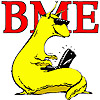
|
| SoE home |

|
| Kevin Karplus's home page |

|
| Biomolecular Engineering Department |
(Last Update: 2017 March 13 09:01 PDT )
The course is intended for sophomores and juniors in bioengineering with priority given to bioengineering majors, but is open to anyone who meets the prerequisites:
Students considering the bioelectronics or assistive technology: motor concentrations should take BME 51A+B early (before EE 101/L), which may be difficult to schedule. Key for the motor concentration is getting CMPE 118 (Mechatronics) in fall of the junior year—scheduling should be designed to ensure that, even at the expense of non-optimal course ordering.
Note: starting in Winter 2017, Applied Electronics for Bioengineers is a sequence of two 4-unit courses, BME 51A (Winter) and 51B (Spring), rather than a 7-unit course plus lab in one quarter, to make the pace more manageable for both students and faculty, and to increase the capacity in the course, which is constrained by the number of lab hours needed a week.
The theme for the course is "connecting real-world signals to computers using analog electronics", and we will be working with interfacing thermistors, microphones, electrodes, photo-detectors, capacitance sensors, and strain-gauge pressure sensors to microprocessors (note microphones and electrodes are in BME 51B, the rest in BME 51A). The signals we will be looking at will be related to physiological measurements (blood pressure, heart beat, and so forth), but the principles can be applied to many other measurements.
The old bioengineering curriculum (before the 2014–15 catalog) will accept BME51A+B as fulfilling the EE101/L (circuits) requirement, but EE will not be accepting it as a prerequisite for further electronics courses. The new (starting 2014–15) curriculum for bioengineers requires BME 51A+B for all concentrations, and EE 101/L in addition for the bioelectronics and assistive technology: motor concentration.
Currently, the best description of the course is on Prof. Karplus's
blog:
http://gasstationwithoutpumps.wordpress.com/circuits-course-table-of-contents/
but most students probably don't want to read the hundreds of pages of
notes there on the design of the course—there is a more compact description
in the textbook.
Students will learn to use standard electronics equipment (multimeters, oscilloscopes, function generators, power supplies) and tools (pliers, wire strippers, breadboards, soldering irons). The course is an engineering design course—I tried to make the labs require design, not just cookbook procedures. The complexity of the design tasks should ramp up through the two quarters.
Because the course had a major rearrangement of the material and change of pace in switching from one intense quarter into two quarters, I will seek frequent feedback from the students in the course about improvements that can be made in the labs, the lectures, and the textbook.
This year the parts and tools are covered by the course lab fees. There are about $70 worth of tools, parts, microcontroller board, and USB cable. These tools and parts will be provided in the first lab meeting, as we will be using them immediately. Dropping the course does not result in a refund of lab fees if you have already gotten the tools and parts.
We have ordered enough kits for the maximum enrollment in the course (plus a couple spares), so dropping after the kits have been issued does not open up many slots for more students. If you are not certain you are going to take the course this quarter, drop the course before the first lab on January 10, so that someone on the waiting list can join the course.
Data acquisition software was developed specifically for this
course, and is available
from http://bitbucket.org/abe_k/PteroDAQ/downloads
under the "Tags" tab. Select the "default" branch under the
"branches" tab and download in zip, gz, or bzip2 archive format.
A version is installed on the lab machines at C:\ProgramFiles\PteroDAQ.
Documentation is downloaded with the source, but only the
installation is reasonably documented right now.
To run the PteroDAQ data acquisition system, you will need Python2.7 or Python3. Note: Mac OS X often comes with an ancient version of Python, so you are likely to need to update your Python. See the documentation at python.org or use the Anaconda Python, which loads a lot of Python modules that are useful. In particular, the filtering software in the SciPy package will be useful for digital filtering of heartbeat signals.
We'll be doing plotting and model-fitting examples with gnuplot. You can choose to use other tools if you are more familiar with them and have sufficient mastery of them to fit complex functions and produce good-looking graphs, but no help will be available for systems other than gnuplot. Gnuplot can be downloaded from the http://www.gnuplot.info/ website, but installation on Macs is sometimes tricky. See the post and comments on Karplus's blog about installing gnuplot on a Mac. The comment by Chuy is probably the most useful.
All the software you need to use should be installed on the lab computers, but you should get your own copies for use on your laptop. All the software is free:
To offset the high parts cost, we'll be using only free on-line material for the textbook.
The book is a fairly large file (18MBytes), so I recommend keeping a copy on your laptop, rather than trying to read it from the LeanPub site each time you need it.
I have been writing this book specifically for this class, and it is not quite done. If there is time, I will be rewriting or expanding portions of the book during the quarter, so you may need to download the PDF file more than once.
In the early years (before my book draft), students found this the most useful of the on-line sources, as the tutorials assume no prior knowledge.
The author of All About Circuits has also made a number of video lectures and practice worksheets available. Not all the worksheets are relevant to this course, but it should be fairly evident which are and which aren't. I may assign some of these, but you are encouraged to try them on your own whether or not they are assigned.
In previous years, many students found the Wikipedia articles too difficult for them, though they are often a better reference than All About Circuits, allowing you to go deeper into the material.
The labs are contained in the textbook, rather than as separate lab handouts. The entire book is is required reading for BME 51A+B—the chapters provide essential understanding for the design work in the labs, and homework will be preparation for the labs.
It is essential to read the lab chapters and do the design work before coming to lab—this is a design class, not lab-demo class, so most of the writing and thinking has to happen before the lab time. Students in past years who did not have completed designs before lab generally wasted a lot of lab time doing pencil-and-paper work and had trouble getting their designs built and tested.
Each lab will be done with a different partner (and occasional singletons). There should be no repeat pairings. Pre-lab work should be done separately, but postlab work can be done together or separately. A detailed design report will be required for each lab (except Lab 1).
| Date | Lab |
|---|---|
| Tues 10 Jan 2017 | Lab 1: setting up |
| Thurs 12 Jan 2017 | Lab 1: setting up |
| Tues 17 Jan 2017 | Lab 2: temperature measurement |
| Thurs 19 Jan 2017 | Lab 2: temperature measurement |
| Tues 24 Jan 2017 | Lab 2: temperature measurement |
| Thurs 26 Jan 2017 | Lab 3: sampling and aliasing |
| Tues 31 Jan 2017 | Lab 3: sampling and aliasing |
| Thurs 2 Feb 2017 | Lab 3: sampling and aliasing |
| Tues 7 Feb 2017 | Lab 4: hysteresis, touch sensor |
| Thurs 9 Feb 2017 | Lab 4: hysteresis, touch sensor |
| Tues 14 Feb 2017 | Lab 4: hysteresis, touch sensor |
| Thurs 16 Feb 2017 | Lab 5: pressure sensor (blood pressure) |
| Tues 21 Feb 2017 | Lab 5: pressure sensor (blood pressure) |
| Thurs 23 Feb 2017 | Lab 5: pressure sensor (blood pressure) |
| Tues 28 Feb 2017 | Lab 5: pressure sensor (blood pressure) |
| Thurs 2 Mar 2017 | Lab 6: optical pulse monitor |
| Tues 7 Mar 2017 | Lab 6: optical pulse monitor |
| Thurs 9 Mar 2017 | Lab 6: optical pulse monitor |
| Tues 14 Mar 2017 | Lab 6: optical pulse monitor |
| Thurs 16 Mar 2017 | Lab 6: optical pulse monitor |
Anyone caught cheating in the class will be reported to their college provost (see UCSC policy on academic integrity for undergrads and for grad students), will fail the assignment, and may fail the class. Cheating includes any attempt to claim someone else's work as your own. Plagiarism in any form (including close paraphrasing) will be considered cheating. Use of any source without proper citation will be considered cheating. If you are not certain about citation standards, please ask, as I hate having to fail students because they were improperly taught how to cite sources.
Collaboration without explicit written acknowledgment will be considered cheating. Collaboration on lab assignments is expected, even required—but that doesn't remove the requirement to acknowledge the collaboration.
| Due | Read | Turn in |
|---|---|---|
| Tues Jan 10 | (Preface optional), Chapter 1, Lab 1 (=Chapter2) | |
| Wed Jan 11 | Chapter 3 | |
| Fri Jan 13 | Lab 2 (=Chapter 6) | Exercises 1.1, 1.2, 3.1–3.3, 6.1–6.3 |
| Mon Jan 16 (NO CLASS) | Chapter 4 | |
| Wed Jan 18 | Exercises 3.4–3.8 | |
| Fri Jan 20 | Chapter 5 | |
| Mon Jan 23 | Chapter 7 | |
| Wed Jan 25 | Chapter 8, oscilloscope video, Lab 3 (=Chapter 11) | Exercise 11.1 |
| Fri Jan 27 | Chapter 9 | Lab 2 report |
| Mon Jan 30 | Chapter 10 | Exercises 9.1–9.5, 10.1–10.3 |
| Wed Feb 1 | Chapter 12, Lab 4(=Chapter 13) | Exercises 8.1–8.5 |
| Fri Feb 3 | Exercises 12.1, 12.2, 13.1–13.4 | |
| Mon Feb 6 | Chapter 14 | Lab 3 report |
| Wed Feb 8 | Lab 2 redone reports | |
| Fri Feb 10 | Exercises 14.1–14.4 | |
| Mon Feb 13 | Chapter 15 | |
| Wed Feb 14 | Lab 5 (=Chapter 16) | Exercises 15.1, 16.1–16.9 |
| Fri Feb 17 | Lab 4 report | |
| Mon Feb 20 (NO CLASS) | ||
| Wed Feb 22 | Chapters 17, 18 | Lab 3 redone reports |
| Fri Feb 24 | Lab 6 (=Chapter 19) | Exercises 18.1–18.4, 19.1, 19.2 |
| Mon Feb 27 | No class, instructor ill | |
| Wed Mar 1 | Lab 4 redone reports | |
| Fri Mar 3 | Lab 5 report | |
| Mon Mar 6 | Chapter 20, Lab 7(=Chapter 21) | Exercises 18.1–18.4, 19.1, 19.2 (again) |
| Wed Mar 7 | ||
| Fri Mar 10 | ||
| Mon Mar 13 | Exercises 20.1–20.5,
21.1– | |
| Wed Mar 15 | ||
| Fri Mar 17 | ||
| Mon Mar 20 | Putative exam time 8a.m.–11 am, probably not used. | Lab 6 report, Last call for all redone reports. NOON. |
|
|
| BME51 home page |
Questions about page content should be directed to
Kevin Karplus
Biomolecular Engineering
University of California, Santa Cruz
Santa Cruz, CA 95064
USA
karplus@soe.ucsc.edu
1-831-459-4250
318 Physical Sciences Building